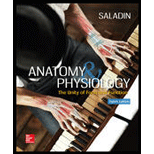
Concept explainers
To discuss:
Spinal gating mechanisms that modify a person’s sense of pain and awareness of body injury.
Introduction:
Structures that are specialized for the detection of a stimulus such as pain and heat are referred to as a sensory receptor. Such receptors can either be real sense organs or simple nerve endings. A sensory receptor converts energy from one form to another. It is involved in the conversion of various forms of stimulus energy, including sound, light, heat, vibration, and touch into nerve signals. Pain indicates the discomfort that typically leads to evasive action. It is caused by noxious stimulation and injury in tissues. The nociceptors indicate the pain receptors that respond to the injuries in tissues and situations that lead to the tissue damage. They occur in the protective tissue called meninges and are responsible for headaches. Nociceptors are tonic receptors since the brain must be aware of the pain all the time.
Want to see the full answer?
Check out a sample textbook solution
Chapter 16 Solutions
Anatomy & Physiology: The Unity of Form and Function
- The ventral root of spinal nerves contains___neurons, whereas the dorsal root contains___neuronsarrow_forwardA spinal reflex requires the participation of each of the following except:a. cerebral cortexb. sensory neuronc. interneurond. motor neuronarrow_forwardA lower motor lesion involving CNVII will result in which of the following: Ipsilateral lower facial paralysis Contralateral lower facial paralysis Contralateral upper and lower facial paralysis Ipsilateral upper and lower facial paralysisarrow_forward
- CSF=cerebral spinal fluid Describe in detail the circulation of CSF starting with where it is produced and ending where it is drained.arrow_forwardA lower motor lesion involving CNVII will result in: Ipsilateral lower facial paralysis Contralateral lower facial paralysis Contralateral upper and lower facial paralysis Ipsilateral upper and lower facial paralysisarrow_forwardAdaptive equipment that is needed for spinal cord injuryarrow_forward
- After leaving the vertebral column the spinal nerves divide into which branch to the supply the body.arrow_forwardBell’s Palsy affects the facial nerve and most often presents with motor symptoms only. Yet the facial nerve is a mixed sensory nerve; suggest possible reasons for this anomaly.arrow_forwardFunction of cerebrumarrow_forward
- Understanding Health Insurance: A Guide to Billin...Health & NutritionISBN:9781337679480Author:GREENPublisher:Cengage
 Medical Terminology for Health Professions, Spira...Health & NutritionISBN:9781305634350Author:Ann Ehrlich, Carol L. Schroeder, Laura Ehrlich, Katrina A. SchroederPublisher:Cengage Learning
Medical Terminology for Health Professions, Spira...Health & NutritionISBN:9781305634350Author:Ann Ehrlich, Carol L. Schroeder, Laura Ehrlich, Katrina A. SchroederPublisher:Cengage Learning



